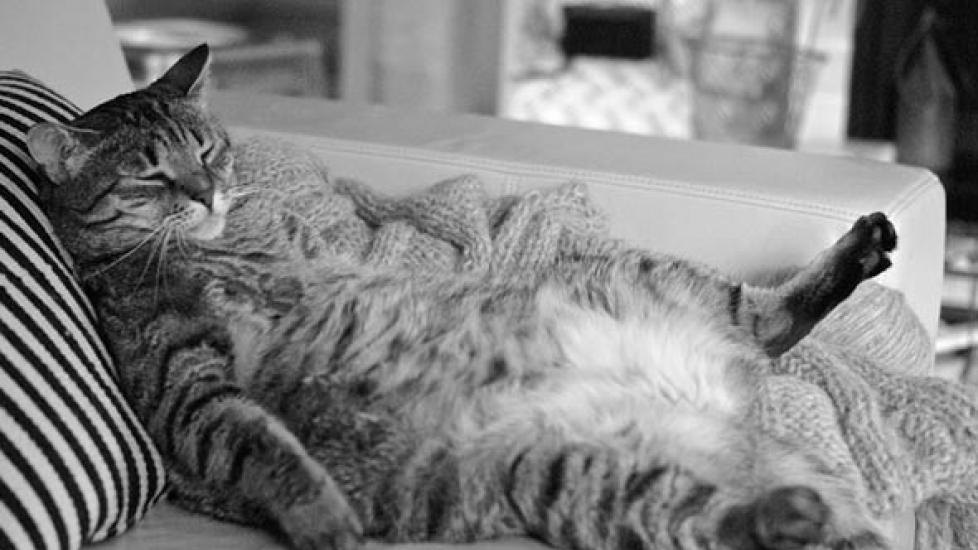Is Being a Fat Cat Really So Bad?
By Ken Tudor, DVM
Feeding the overweight cat is simultaneously both the easiest and the most complex of tasks. With few exceptions—like the Maine Coon at the large end and the emaciated looking Siamese at the small end—the ideal target weight for most cats is approximately 10 pounds.
Unlike with dogs, we know the exact size of the thin cat inside Garfield and how many calories he needs. But administering that feeding program is nearly impossible. Cat eating behavior makes scheduled feedings very difficult, especially for working owners, and the unique carnivorous feline metabolism can put a dieting cat at risk for potentially fatal liver problems. The multi-cat household adds even more challenge and frustration.
How Many Calories to Feed the Overweight Cat
No matter which of the many calculations we use to determine how much to feed the dieting cat, they all yield virtually the same number of calories: 200-225 calories, or kcal. This starting number can be reduced to as low as 150 if necessary. And this is important: Before you begin restricting your cat’s calories, remember to consult your vet. There may be health issues that are particular to your cat that will inform exactly how many calories your cat will need.
Cats Eat Around Eight Times a Day
If only these creatures ate like dogs and we could schedule their feedings and monitor their food intake. But they don’t. Cats are more content eating small meals, 6-8 times a day, at about 30 calories at a time. Ancestral meals were around the same size; a mouse contains just about 30 calories!
Modern cats eat like their ancestors, but without the hunt. Few owners have time to supervise 6-8 meals a day, and imposing 2-3 scheduled feedings is likely to result in inadequate food intake. As all cat owners know, offering a cat dry, crusted canned food from the last feeding will result in litter burying behavior rather than eating behavior. And few cats will eat 1/4 to 1/3 cup of dry cat food at one time.
Stress from Dieting Can Affect the Cat's Liver
As obligatory carnivores, cat metabolism required unique evolutionary development. The cat liver processes the protein in meals into energy, glucose (body sugar), and the amino acids and proteins their bodies require. This processing requires a store of fat from the meal, or from other body fat. The normal cat liver contains very high levels of working fat.
Cats will decrease their food intake because of the stress created by boarding, new pet sitters, moving to a new location, the turmoil of special family events or construction, and most importantly, changes in feeding practices and food quantities—i.e., changes to the diet, especially for weight loss. Decreased food intake results in fat recruitment to the liver to process the amino acids recruited from muscles. The liver becomes even more fatty than normal.
As this vicious cycle continues, a fatty liver, or hepatic lipidosis can occur. Without timely treatment, this condition is often fatal. Again, consult your vet before putting your cat on a weight loss diet.
Feeding a Fat Cat in a Multi-Cat Household
The feeding routine in multi-cat households can be daunting. The complex social structure, with its sometimes invisible dominance/subordinate interactions, dictates the feeding routine. Changing the routine to limit the food intake of the overweight pet can put pressure on this setting.
Feeding the overweight cat separately often means isolating them or remodeling the living arrangement to allow only some of the cats access to certain areas (doors with electronic or magnetic responders). These solutions often influence the delicate social structure and cause disputes and other disruptive behavior. Generally, two to three scheduled feedings of canned food go well, but regulating the other dry food meals, especially in the owner’s absence, is difficult.
Multiple cat food stations or food puzzles are one solution. Two to three more feeding stations than the number of cats, each containing 25-30 calories, work for many households. For other households, the results are dismal and can result in decreased food consumption for all cats, putting all of them at risk of hepatic lipidosis.
The Reality: Dieting May Not Stick
Don't get discouraged, but these are some of the realities for owners who are seeking weight loss solutions for their overweight cats. It can be complicated and difficult to adhere to a strict diet. In practice, many cats stay fat and happy… and eventually diabetic.
This article is a revision of an original column by Dr, Tudor, titled Why Most Cats Stay Happy, Fat Cats.
